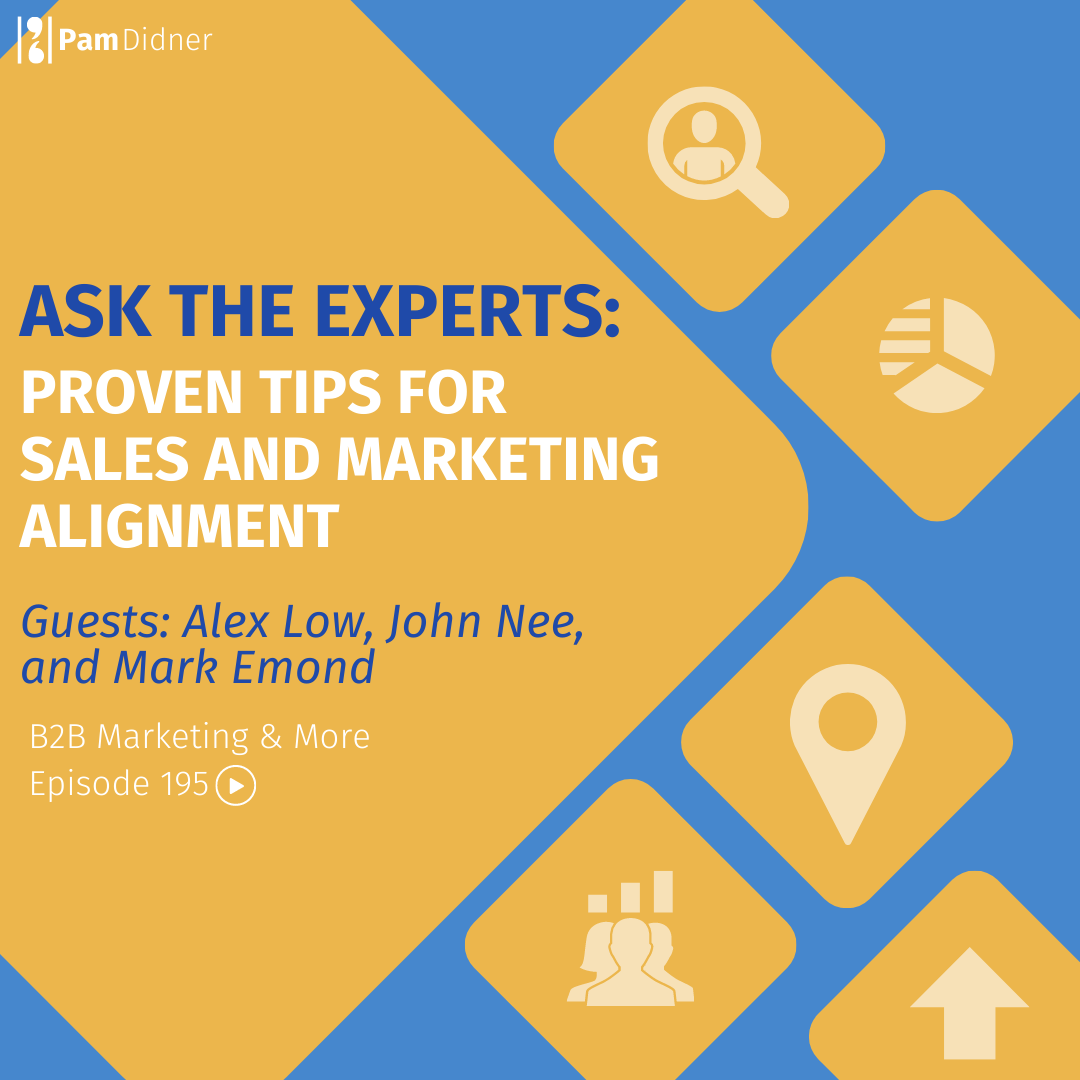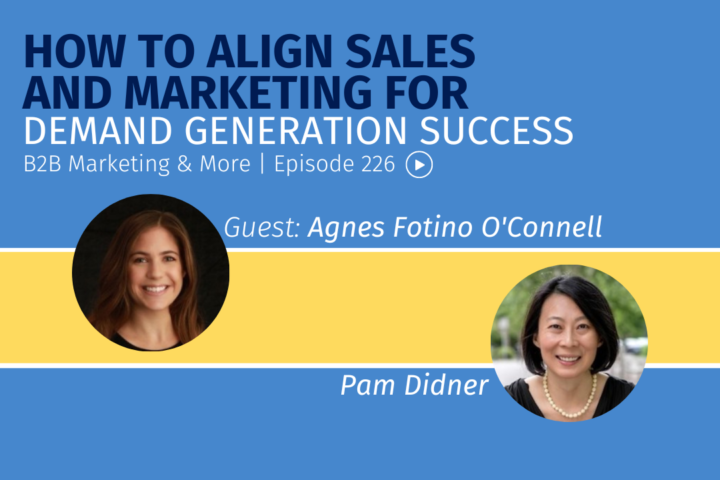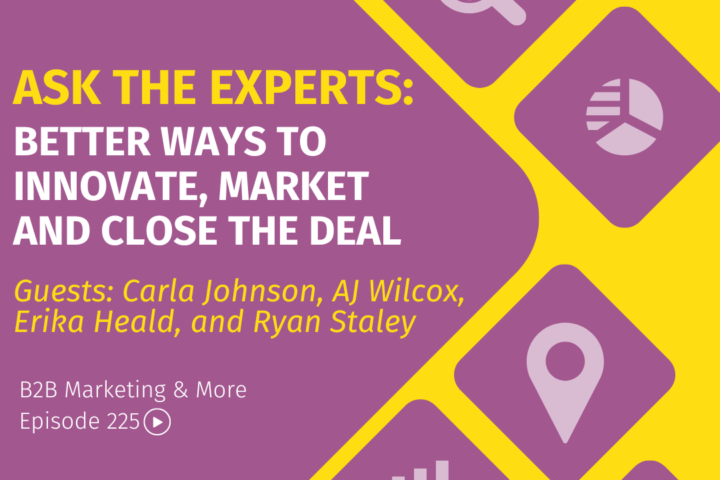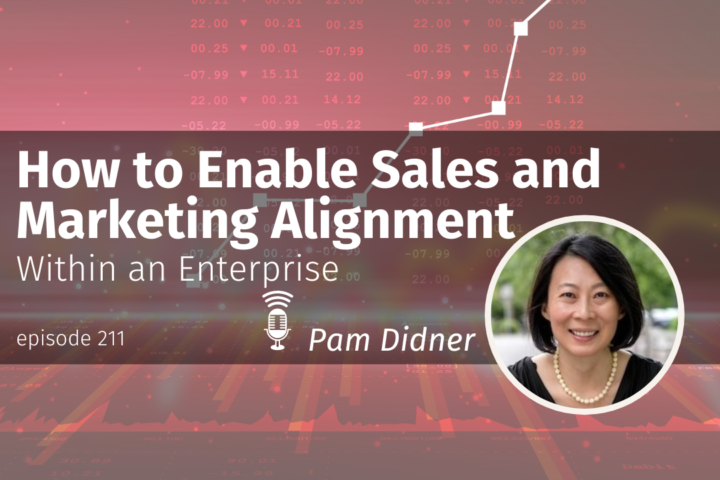
Hello from Raleigh, North Carolina. Welcome to another episode of B2B Marketing & More.
Today’s episode features some of my previous guests and a topic that comes up in almost all my podcast conversations: How can sales and marketing teams work together? The answer isn’t that simple because so much has changed with the pandemic in the past two years. At the same time, there were also many changes in digital marketing and the corporate culture within the businesses is different from company to company, from industry to industry.
In this episode:
- John Nee is the Principal and President of Act1 Partners and has worked many years helping marketers and salespeople better collaborate and support each other. John shares expert tips on what marketing departments can do to better support sales.
- Alex Low is a Managing Consultant at PA Consulting in London and an advisor for the social media management platform Lately. He does a lot of work around business development and sales transformation. Our conversation was focused on expert tips for social selling, and how to align marketing and sales.
- The reality is both sales and marketing need to work together – on the top, middle and bottom of the funnel. Mark Emond is a revenue marketing expert and the President of Demand Spring, and he shares insights that will help you sync marketing and sales collaboration.
Quotes from the episode:
“The single greatest thing they can do is try to put themselves in the shoes of the sales force. I don’t think there’s any better way to do that than to go on sales calls. Do some ride-along sales calls, get on conference calls in this virtual world that we now live in and engage as much as possible with the customer and the prospect to learn how that sale happens.” – John Nee
“So you have a marketing person, a Demand Gen person, a content person, and you need to achieve that number by the end of the year. Go do it work together as a team, and figure out the best way to generate those conversations.” – Alex Low
“If you don’t have motivation coming from above to drive a new way of doing things, the desire to change the behavior is not going to be there.” – Mark Emond
—————
Enjoy the podcast? Subscribe to the show on your favorite podcast platform, leave a 5-star review and subscribe to Apple Podcasts.
If you prefer watching a video, I also have a YouTube Channel; check it out and subscribe.
If you want to chat, reach out to any social media channels or email me at hello@pamdidner.com. You can also join my Facebook community: Build Your Marketing Skills to Get Ahead. When you join, you get a free Starbucks on me. You can go to the Announcement tab and click on the barcode of the gift card.
To expand your knowledge and explore more expert tips on sales enablement, check out some of my previous podcast episodes, blog posts, and videos.
Podcast episodes
Tips and Tricks of Sales and Marketing Collaboration
Who Owns Sales Enablement and B2B Marketing
Qualified Leads: Reduce Tension Between Sales and Marketing
Blog post
5 Steps to Creating Harmony Between Marketing and Sales to Grow Your Business
Video
3 Creative Ways Marketing Can Support Sales
TRANSCRIPT
Hello from Raleigh, North Carolina. Welcome to another episode of B2B Marketing & More. Today I have a special episode for you featuring a topic that comes up in almost all my conversations here on the podcast. How can sales and marketing teams work together? The answer isn’t that simple because so much has changed with the pandemic in the past two years. At the same time, there were also many changes in digital marketing in the field of digital marketing. And the corporate culture within the business is different from company to company, from industry to industry.
As I look back in the past, I found some nuggets of wisdom from several guests in one year of conversations. I would like to share with you, and it’s worth revisiting.
I want to start with my longtime friend and colleague in Portland, Oregon, John Nee.
John is Principal and President of Act1 Partners and has worked many, many years helping marketers and salespeople better collaborate and support each other. Since I’m speaking with marketers here, I asked him the most important questions that everybody’s struggling with–what can we do to better support sales?
John Nee: I think the single greatest thing they can do is try to put themselves in the shoes of the sales force. I don’t think there’s any better way to do that than to go on sales calls. Do some ride-along sales calls, get on conference calls in this virtual world that we now live in and engage as much as possible with the customer and the prospect to learn how that sale happens. Because through that process, a marketer can then empathize with the salesperson and their needs. And help create a campaign or help create sales tools that can empower the salesperson to do their job more effectively.
Pam Didner: That’s a great answer. I make those suggestions at my workshops all the time – have a marketers tag along with the salespeople, or even attend a huddle meeting or a sales call. But I got some feedback from time to time from marketers that the sales team don’t want them to be. What is your recommendation or suggestion in terms of what they do to change?
John Nee: Well, I think there’s a couple of things. I’d want to unpack why they wouldn’t want the marketing people to join them. I think there is a level of respect that needs to be earned by marketing for sale. I also think it helps to tie compensation with the product’s success, particularly on the product marketing side.
Pam Didner: Are you talking about the marketer should take on the incentive as well? Is that the marketer?
John Nee: I think the product marketing, in particular, should have a bonus or some sort of compensation tied to the success of that product being. And it’s not uncommon for product marketers to have a bonus or some sort of compensation tied to the success of that product. I think that will again allow them to better understand the demands of the customer and the challenges in the marketplace of moving that product in the most.
Pam Didner: Yeah, but I do agree with you that a marketer needs to earn salespeople’s respect. I’m using myself as an example; I’ve worked with the sales team for 10, 15 years. When I started, I remember talking to my salespeople and saying, Hey, can I join the call? And they say, no. And, um, in general, when they say, no, you need to think about in terms of why you cannot. You know, why can you provide value to them?
And that they can see that you provide value. So you can tag along to a sales call over some time.
I was able to share marketing campaigns or even co-marketing ideas that they can use, or even share some of the content we created on the marketing side, but structured in a way they understand.
And then share with the salespeople and tell them that you know how they can use some of the content we created. But I do agree with you in terms of you have to earn their respect. Yeah.
John Nee: Right.
That was John Nee from Act1 Partners. As you heard there, we briefly touched on the topic of compensation and incentives. It feels like it has only been in the last several years where discussions have opened up more too, “Hey, marketing can help close sales deals. What about incentives and also bonuses for marketing people?” So, John talked about that specifically with the product marketers.
The trick is we don’t always know whether it was a sales call, a piece of messaging or content or a social media post that clinched the deal.
With more happening in the digital realm, it gets a whole lot trickier. And I spoke about this with Alex Low earlier this year. Alex is a Managing Consultant at PA Consulting in London and an advisor for the social media management platform Lately. He does a lot of work around business development and sales transformation. Our conversation was focused on social selling, which is a hot topic for many salespeople. At one point, I asked Alex the same question that I asked John–how can marketers help sales? As you’ll hear, Alex and I both have strong feelings about that.
Alex Low: If you’d ask her this, ask me 20 years ago. I just said you’re the coloring in the department. Doesn’t go outside the lines. And you’ve only got a job because of my sales,
Pam Didner: Like stop messing me. All right. Just stop messing me around, staying in your lane. All right. I stay in my lane and the way. All right. I hear you. I mean, my salespeople told me that before,
Alex Low: Uh, fast forward to where I am today. I see myself as a bad marketer, as much as a marketer, as I do as, as a salesperson, everything that we’ve, um, we’ve talked. And I also believe marketing habits are hard because different KPIs drive them. Use likes, impressions, website, visits, clicks, again, kind of all meaningless. If you don’t know, kind of bought your way or you’re trying to get,
Pam Didner: Yeah. I call them vanity metrics. I mean, they have their place, but at the end of the day, if it doesn’t show any kind of sales impact over a long period of time, senior management is going to ignore it.
Alex Low: Yeah. And the most time, they say the impression to senior management, didn’t even know what an impression mean, how come I say, talk to them?
What are you hearing? What do you hear on the ground? And what are your customers telling you? What should we be talking about? How can I help you? Turn that into a story. We can put it back through social for you. Marketing data gives the salespeople everything in terms of whatever data analytics you can, uh, you can get from your website because last you may see one thing, a salesperson go.
What’s that over there. What’s that company. What? I was only talking to them three days ago. What are they signed up for? What have they downloaded? I had a brilliant story from SDR, where they asked their marketing team for all the unsubscribed. So you said, give me all the people that have unsubscribed from my marketing list. Why? Because I’m going to call them, why just give me the list. He only fed them methodically called them. And he generated a number of business leads on the back of it, because the reason, the person that unsubscribed from the marketing, the marketing emails. Cause they, well, I’m not interested in that.
He’s like, what are you interested in? Well, this, this and this, well, that’s funny because we do that. Do you? I had no idea because my inbox has just been inundated with this kind of stuff.
We were starting to think about how can we use our marketing data.
Different ways in a more sophisticated way. How can we start looking at that top of the funnel if we’re going to go there? And then how’s that tie into our CRM data? Where did that lead genuinely come up? That’s why I think MQL and SQL need to cease to exist. It’s just a qualified lead.
Pam Didner: I take a, from a slightly different perspective, Alex, I think it’s okay to have MQL and SQL exist. But the thing is, you have to make that super, super clear. It cannot be a very vague definition. For example, can we make the MQL definition so clear that the NQL definition is, you know, a person that raised the hand to request a demo? There’s no confusion whatsoever. The only way that NQL or a marketing person can get credit is that person raised a hand, say I wanted to see a demo.
And then the SQL may be that, you know, you pre qualify that person who raised the hand, coy hand raiser.
You qualified the present and did that person match the ICP–Ideal Customer Profile. Yeah. So I think NQL and SQL can exist, but you have to make that super clear. There’s no confusion whatsoever between these two terms, right? But that makes marketing’s job so much harder. It’s not based on lead scoring anymore. It’s not based on a number of the downloads; it’s not based on this specific person. I opened my emails three times and clicked on five different pieces of content. Got the lead score of 98. Nobody gives a crap about that at the end of the day. Did the person raise a freaking hand? If that person raised their hand and you see it as an MQL, great. Then you can take credit.
But other than that, you can’t. But that is so specific. I think marketers, including myself, sometimes I was like, do I want to take that? Do I want to make that very clear? You know, then from my perspective is not 1000 leads or NQL that the prison needs. The market needs to generate. Maybe 1000 MQL needs to go down to 25, but I’m not sure that the marketing team is willing to confront that sometimes.
Alex Low: But we then come into and, um, I agree to a certain extent on, on the, on the MQL stuff. My view is that they raised their hand.
They should have gone through enough of a journey that we know there, and they are ICP.
We could debate this until the cows come home, then the tension between sales and marketing. Cause everyone’s KPI’d differently. Do not tie in with what a salesperson’s trying to achieve.
So maybe when I got it, I discussed this with a gentleman called Patrick Joyce a couple of months ago. His view is that we should act in kind of pods. So you have a marketing person, a Demand Gen person, a content person, and you need to achieve that number by the end of the year. Go do it work together as a team, and figure out the best way to generate those conversations. And those leads that turn into things. I completely agree with you, though. I’d far rather have 25 buttoned-down, that is, that will convert that a thousand, just like, oh, whatever.
Pam Didner: Yeah. I achieve at least… By the way, I’m not saying lead scoring is not helpful. That’s not very helpful. You can look at that as a 10, right if they download the pricing guide, right. And that levels. Maybe that person might be interested in a guy, that person might be interested. We need to, you know, do a nurturing a little bit differently. Lead scoring has its place.
Alex Low: I completely agree.
Pam Didner: I’m just saying it’s not how I would use it to pass the lead to the sales team.
That was Alex Lowe, a consultant at PA Consulting. He’s also the host of The Death of a Salesman podcast.
There is no doubt with an increase in digital channels. Customers can come in and talk to us at different touchpoints. With that change, we have seen that salespeople and marketers are finding themselves shifting and adjusting their roles. So the purchase funnel is no longer that marketers focused on the top of the funnels. The salespeople are responsible for the middle and the bottom of the funnel.
The reality is both sales and marketing need to work together – on the top, middle and bottom of the funnel. Because we have to work so closely together that times we will be tripping over each other. So I spoke with Mark Emond about this shift, and he’s a revenue marketing expert and the President of Demand Spring in Ottawa, Ontario. I asked Mark how he dresses the new role of buying for sales and marketing. How can we work together?
Mark Emond: The first thing we always start with is just a good recognition and a discussion with sales leaders and marketing leaders about the buyer’s role today, right?
Typically in a B2B buyer journey today, or in a considered purchase for B2C, if you’re buying a car or a house, it’s not sales that are in control anymore. Unlike when you and I started our career, Pam; it’s not marketing; it’s the buyer, right? The buyer using digital channels, using the content available through digital channels is self-educating through a lot of the buyer journey. They’re engaging interdependently in a non-linear manner with marketing and sales.
They’re the ones calling the shots. Right? So, we have seen in the last. I’ll say three to four years, more and more sales or traditional sales organizations kind of recognize that they need to change that.
Pam Didner: I hear you. I have seen this something similar, as well. What can with manufacturing companies specifically, right? Manufacturing company or supply chain, any kind of, um, I would say the materials-handling type of organization.
They tend to be the last segment to change because the longest time in the past 50 years, how do they get their sales?
Well, their salespeople have a relationship. They go attend the events or build a relationship with the specific accounts, and that’s how they close the deal.
They never really, um, had to work very closely with the marketing people. But I agree with you that many seasoned salespeople recognize a shift in how the buyers or their customers are interacting with them. They have to move themselves a little bit upstream. And the way to do that is working very closely with sales.
I love your ideas when you have a conversation with the salespeople, bring the buyers behaviors, and also, you know, how they buy right now, uh, as a part of the discussion. I think that’s a great, great suggestion.
Mark Emond: Yeah. The one other thing that we see too is there’s, there’s also, you know, a bit of a demographic shift going on, even knowing sellers as well. Right?
We do a lot of work in the financial services industry and wealth management, and asset management.
Traditionally, the wealth or asset managers’ sales reps have relationships with financial advisors, brokers, and dealers. It’s been, as I like to say, “old white guys talking to old white guys.” We’re seeing a demographic shift now, both amongst advisors, brokers, dealers, and the sales team in wealth managers. Right. It reflects more diversity of ages and stages of life, certain racial and gender diversity as well. So that’s also helping, right?
I think there’s kind of this, this turnover to some degree too, of the individuals’ demographics. And they’re recognizing that you know, Hey much, like in our personal lives, it’s not, you know, like when we bought a car 25 years ago, right. We’d go to the dealership, and the sales rep at the dealership would be the voice of education through much of a buying experience. And now when we go buy a car right there at the dealership–
Pam Didner: We sometimes know more than they do.
Mark Emond: Absolutely. Right. And I think in the future, right, we’ll be doing test drives through virtual reality. We’ll just go in to pick up the keys. Um, and then, you know, so I think there’s a shift going on.
Pam Didner: Definitely. So, um, I would like to get your thought in terms of sales and marketing alignment. Do you think the marketers can do sales and marketing alignment bottom-up and without top management support?
Mark Emond: No in one word. No, no. I think you need executive sponsorship.
Pam Didner: I 100% agree with you. I mean, I ran into that question multiple times and, uh, that, you know, the worker bees have that orientation to work with the sales team. Still, they cannot pool the traction and if their CMOs all the VPO marketing on not supporting it, I don’t think there’s any other way out. You have to get a management alignment between the VP of Sales and CMOs, VP of Marketing. I think it has to be a top-down driven initiative. And I have said that multiple times in the past, and I also have people arguing with me, but I kind of want to hear your perspective on that one.
Mark Emond: Well, I think it comes down to incentives, right. As we all know, people in general and certainly sales rep/sales leaders are motivated by, and their behavior is a function of what they’re incentivized on. Right. So if you don’t have motivation coming from above to drive a new way of doing things, the desire to change the behavior is not going to be there.
I will add that even in a top-down approach where you’ve got executive sponsorship, the most important function in sales and marketing alignment, in my experience, is always the first level sales managers in the regions. If they don’t support sales and marketing alignment, the sales leaders that the individual reps report into will fall.
That was Mark Emond of the Demand Spring.
Listening back on these conversations. I feel so lucky that I get to talk with marketers from all over the world about sales and marketing, my favorite topic. The relationships between these teams can be very challenging. Still, it makes a tremendous difference to a brand, your company, and reaching the business goal together when it works well.
As I look ahead, here is what I see for sales and marketing.
#1: Working with sales as a marketer to support them is more important than ever before. You need to explore that and find a way to support them.
#2: As a part of your annual planning, invite your sales team to join you. Understand the needs. Talk to them.
#3: Understand the challenges at every single sales stage and the final way to support them. So you are not just focusing on the top of the funnel.
I hope that makes sense. And do you find that view useful if you like to hear the conversations in this episode in full? Check out the show notes for links to each episode.
Thank you so much for listening.



